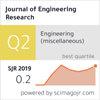科威特三大再循环多级闪蒸海水淡化厂的能源和能效分析
IF 2.2
4区 工程技术
Q3 ENGINEERING, MULTIDISCIPLINARY
引用次数: 0
摘要
本研究比较了30年来不同时期建造的三个多级闪蒸(MSF)海水淡化厂的热性能。本研究中考虑的MSF海水淡化厂分别是1978年、2001年和2007年建成的Al-Doha East、Al-Zour和Al-Sobia。利用实际运行数据,根据热力学第一定律和第二定律对三个MSF海水淡化厂进行了分析。热性能比较包括不同部件的能耗、用能消耗、第二定律效率和用能破坏。结果表明,Al-Sobia MSF海水淡化厂的能耗比Al-Doha East和Al-Zour低17%,能耗低21%。结果还表明,Al-Sobia海水淡化厂的第二定律效率最高,为6.9%,而Al-Doha East和Al-Zour的第二定律效率分别为5.4%和5.5%。Al-Sobia海水淡化装置的热电能耗也较低,这可以通过其高性能比、高热交换器效率、高回收率和高盐顶温度(TBT)来解释。另一方面,脱硫装置的低用能消耗是由于除过热器和喷射器的低用能破坏。与Al-Doha East和Al-Zour装置相比,Al-Sobia脱过热器的火用破坏较低,因为高TBT和高压力产生了较少的蒸汽抽提和较高的出口流量火用。本文章由计算机程序翻译,如有差异,请以英文原文为准。
Energy and exergy analysis of three major recirculating multi-stage flashing desalination plants in Kuwait
This study compares the thermal performance of three Multi-Stage Flashing (MSF) desalination plants constructed at various dates over 30 years. The MSF desalination plants considered in this study are Al-Doha East, Al-Zour, and Al-Sobia, built in 1978, 2001, and 2007, respectively. Using actual operating data, analyses based on the first and second laws of thermodynamics were conducted to study the three MSF desalination plants. The thermal performance comparisons included energy consumption, exergy consumption, second law efficiency, and exergy destruction in different components. The results showed that the Al-Sobia MSF desalination plant yielded 17% lower energy consumption and 21% lower exergy consumption than Al-Doha East and Al-Zour. The results also showed that the Al-Sobia desalination plant had the highest second-law efficiency of 6.9%, compared to 5.4% and 5.5% for the Al-Doha East and Al-Zour. The Al-Sobia desalination plant also had less thermal and electrical energy consumption, which can be explained by the high-performance ratio, high heat exchanger effectiveness, high recovery ratio, and high Top-Brine Temperature (TBT). On the other hand, the low exergy consumption of the Al-Sobia desalination plant is due to the low exergy destruction in the de-superheater and ejectors. Compared to the Al-Doha East and Al-Zour plants, the Al-Sobia de-superheater had lower exergy destruction because of less steam extraction and higher exit flow exergy from the high TBT and pressure.
求助全文
通过发布文献求助,成功后即可免费获取论文全文。
去求助
来源期刊

Journal of Engineering Research
ENGINEERING, MULTIDISCIPLINARY-
CiteScore
1.60
自引率
10.00%
发文量
181
审稿时长
20 weeks
期刊介绍:
Journal of Engineering Research (JER) is a international, peer reviewed journal which publishes full length original research papers, reviews, case studies related to all areas of Engineering such as: Civil, Mechanical, Industrial, Electrical, Computer, Chemical, Petroleum, Aerospace, Architectural, Biomedical, Coastal, Environmental, Marine & Ocean, Metallurgical & Materials, software, Surveying, Systems and Manufacturing Engineering. In particular, JER focuses on innovative approaches and methods that contribute to solving the environmental and manufacturing problems, which exist primarily in the Arabian Gulf region and the Middle East countries. Kuwait University used to publish the Journal "Kuwait Journal of Science and Engineering" (ISSN: 1024-8684), which included Science and Engineering articles since 1974. In 2011 the decision was taken to split KJSE into two independent Journals - "Journal of Engineering Research "(JER) and "Kuwait Journal of Science" (KJS).
 求助内容:
求助内容: 应助结果提醒方式:
应助结果提醒方式:


